Critically Analyzing Key People Issues in International HRM Context
VerifiedAdded on 2023/06/14
|14
|4073
|327
Essay
AI Summary
This essay provides a critical analysis of key people issues and challenges in the context of global organizations, focusing on International Human Resource Management (IHRM). It begins by defining IHRM and its importance in managing human resources within multinational corporations, emphasizin...
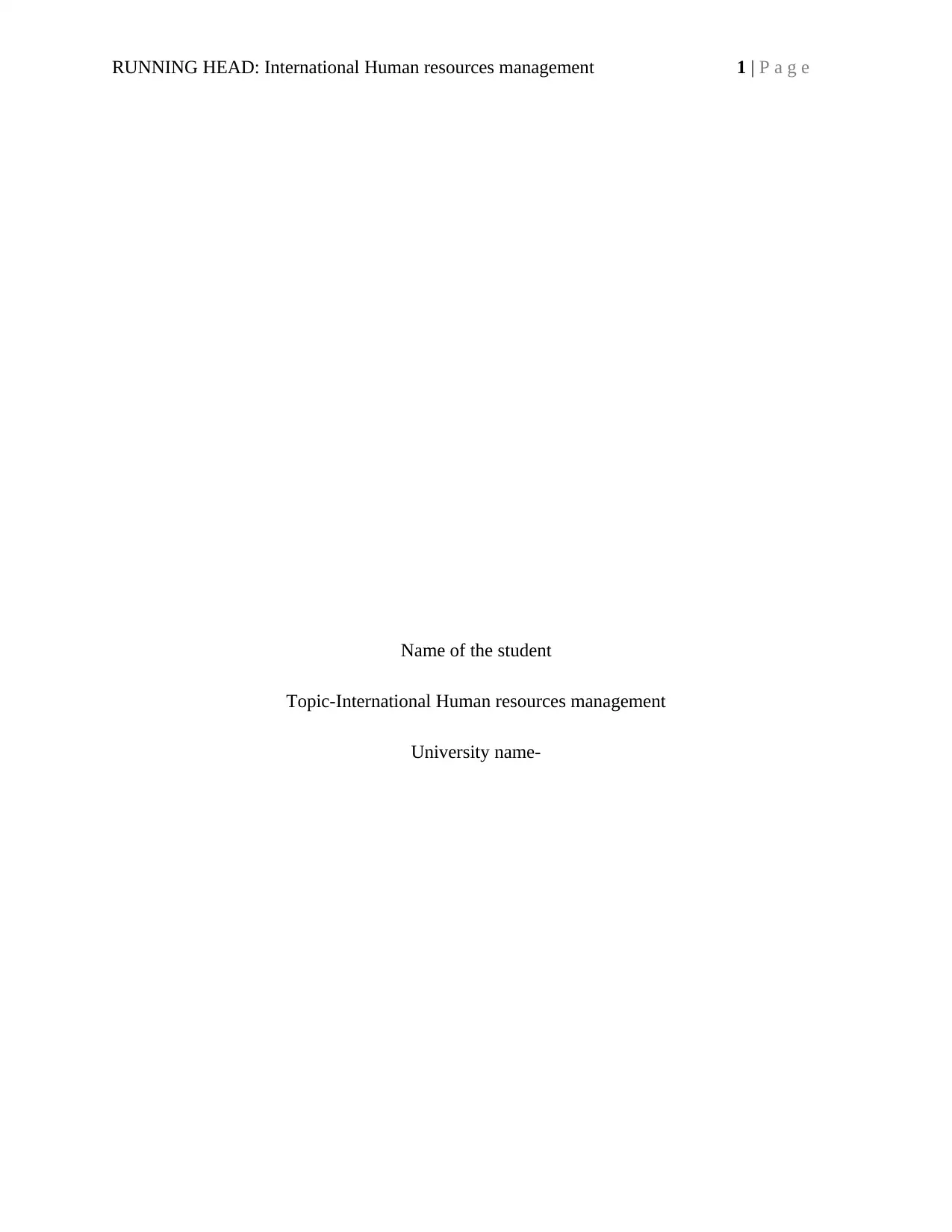
RUNNING HEAD: International Human resources management 1 | P a g e
Name of the student
Topic-International Human resources management
University name-
Name of the student
Topic-International Human resources management
University name-
Secure Best Marks with AI Grader
Need help grading? Try our AI Grader for instant feedback on your assignments.
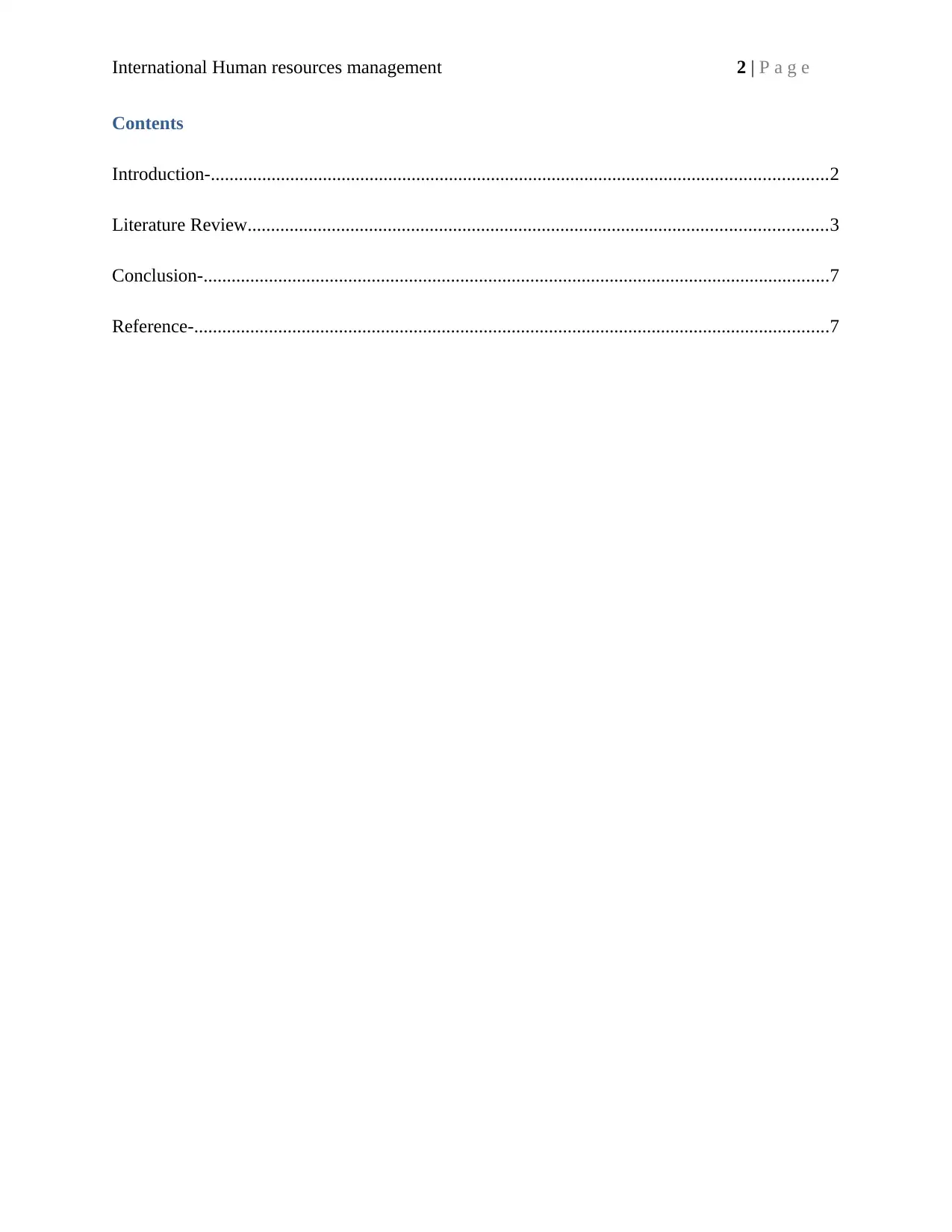
International Human resources management 2 | P a g e
Contents
Introduction-....................................................................................................................................2
Literature Review............................................................................................................................3
Conclusion-......................................................................................................................................7
Reference-........................................................................................................................................7
Contents
Introduction-....................................................................................................................................2
Literature Review............................................................................................................................3
Conclusion-......................................................................................................................................7
Reference-........................................................................................................................................7
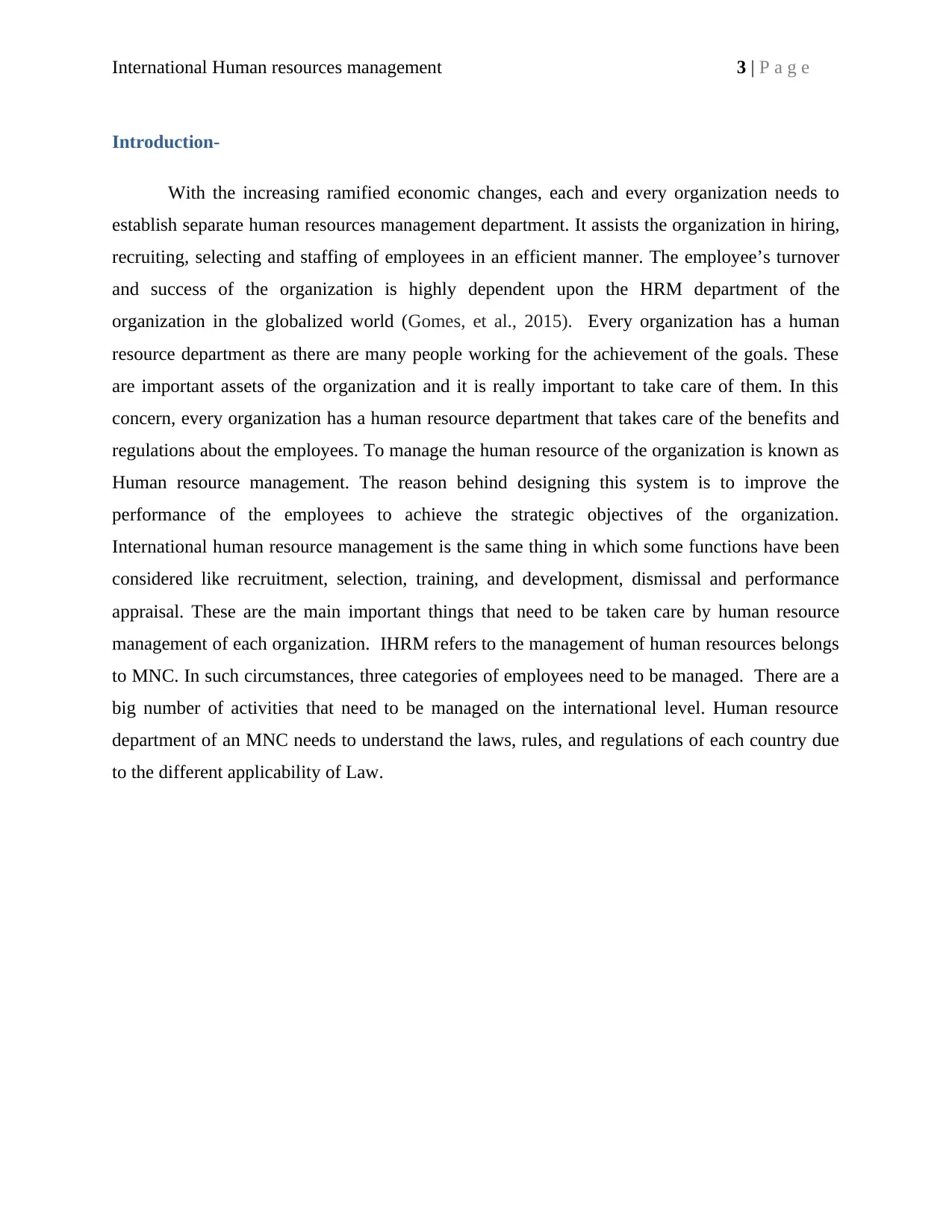
International Human resources management 3 | P a g e
Introduction-
With the increasing ramified economic changes, each and every organization needs to
establish separate human resources management department. It assists the organization in hiring,
recruiting, selecting and staffing of employees in an efficient manner. The employee’s turnover
and success of the organization is highly dependent upon the HRM department of the
organization in the globalized world (Gomes, et al., 2015). Every organization has a human
resource department as there are many people working for the achievement of the goals. These
are important assets of the organization and it is really important to take care of them. In this
concern, every organization has a human resource department that takes care of the benefits and
regulations about the employees. To manage the human resource of the organization is known as
Human resource management. The reason behind designing this system is to improve the
performance of the employees to achieve the strategic objectives of the organization.
International human resource management is the same thing in which some functions have been
considered like recruitment, selection, training, and development, dismissal and performance
appraisal. These are the main important things that need to be taken care by human resource
management of each organization. IHRM refers to the management of human resources belongs
to MNC. In such circumstances, three categories of employees need to be managed. There are a
big number of activities that need to be managed on the international level. Human resource
department of an MNC needs to understand the laws, rules, and regulations of each country due
to the different applicability of Law.
Introduction-
With the increasing ramified economic changes, each and every organization needs to
establish separate human resources management department. It assists the organization in hiring,
recruiting, selecting and staffing of employees in an efficient manner. The employee’s turnover
and success of the organization is highly dependent upon the HRM department of the
organization in the globalized world (Gomes, et al., 2015). Every organization has a human
resource department as there are many people working for the achievement of the goals. These
are important assets of the organization and it is really important to take care of them. In this
concern, every organization has a human resource department that takes care of the benefits and
regulations about the employees. To manage the human resource of the organization is known as
Human resource management. The reason behind designing this system is to improve the
performance of the employees to achieve the strategic objectives of the organization.
International human resource management is the same thing in which some functions have been
considered like recruitment, selection, training, and development, dismissal and performance
appraisal. These are the main important things that need to be taken care by human resource
management of each organization. IHRM refers to the management of human resources belongs
to MNC. In such circumstances, three categories of employees need to be managed. There are a
big number of activities that need to be managed on the international level. Human resource
department of an MNC needs to understand the laws, rules, and regulations of each country due
to the different applicability of Law.
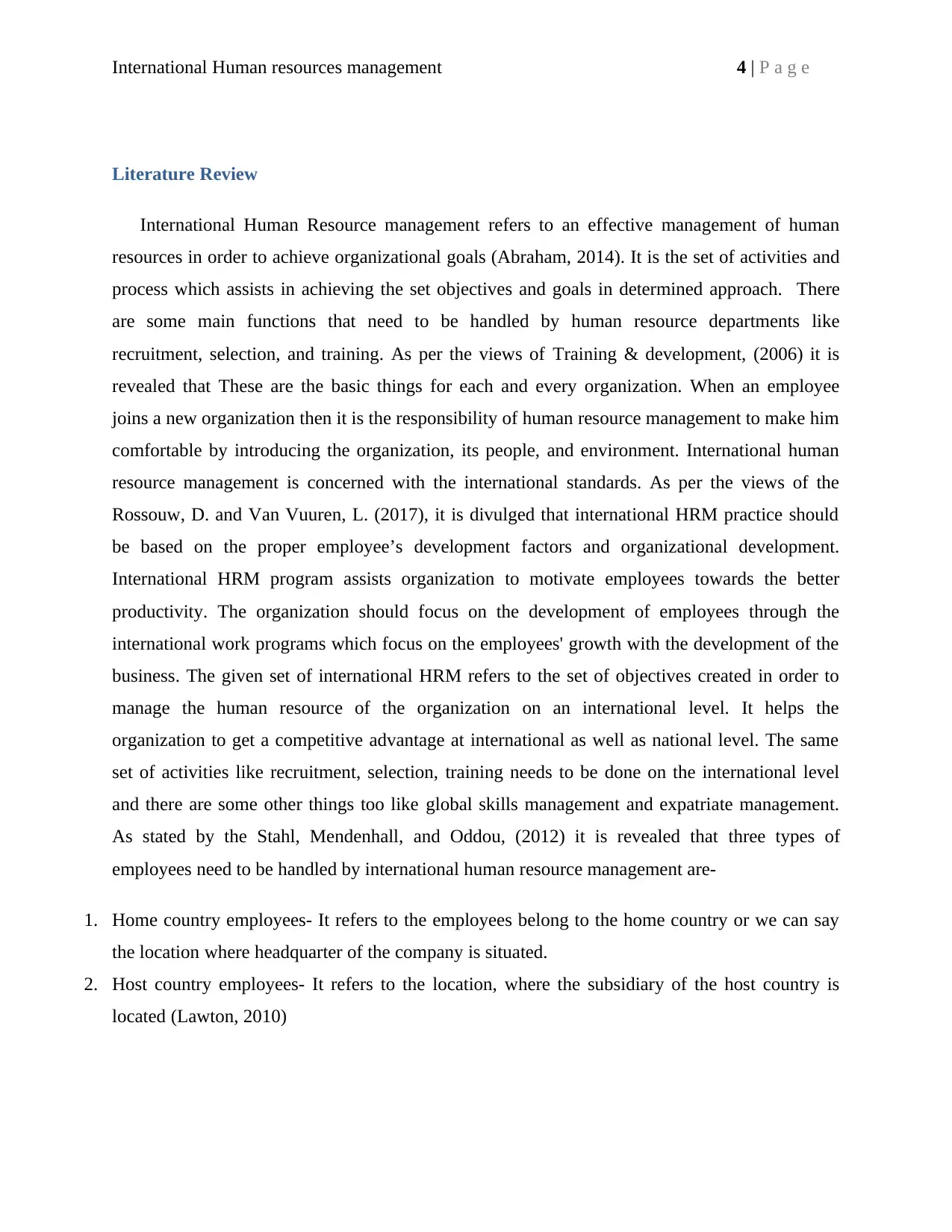
International Human resources management 4 | P a g e
Literature Review
International Human Resource management refers to an effective management of human
resources in order to achieve organizational goals (Abraham, 2014). It is the set of activities and
process which assists in achieving the set objectives and goals in determined approach. There
are some main functions that need to be handled by human resource departments like
recruitment, selection, and training. As per the views of Training & development, (2006) it is
revealed that These are the basic things for each and every organization. When an employee
joins a new organization then it is the responsibility of human resource management to make him
comfortable by introducing the organization, its people, and environment. International human
resource management is concerned with the international standards. As per the views of the
Rossouw, D. and Van Vuuren, L. (2017), it is divulged that international HRM practice should
be based on the proper employee’s development factors and organizational development.
International HRM program assists organization to motivate employees towards the better
productivity. The organization should focus on the development of employees through the
international work programs which focus on the employees' growth with the development of the
business. The given set of international HRM refers to the set of objectives created in order to
manage the human resource of the organization on an international level. It helps the
organization to get a competitive advantage at international as well as national level. The same
set of activities like recruitment, selection, training needs to be done on the international level
and there are some other things too like global skills management and expatriate management.
As stated by the Stahl, Mendenhall, and Oddou, (2012) it is revealed that three types of
employees need to be handled by international human resource management are-
1. Home country employees- It refers to the employees belong to the home country or we can say
the location where headquarter of the company is situated.
2. Host country employees- It refers to the location, where the subsidiary of the host country is
located (Lawton, 2010)
Literature Review
International Human Resource management refers to an effective management of human
resources in order to achieve organizational goals (Abraham, 2014). It is the set of activities and
process which assists in achieving the set objectives and goals in determined approach. There
are some main functions that need to be handled by human resource departments like
recruitment, selection, and training. As per the views of Training & development, (2006) it is
revealed that These are the basic things for each and every organization. When an employee
joins a new organization then it is the responsibility of human resource management to make him
comfortable by introducing the organization, its people, and environment. International human
resource management is concerned with the international standards. As per the views of the
Rossouw, D. and Van Vuuren, L. (2017), it is divulged that international HRM practice should
be based on the proper employee’s development factors and organizational development.
International HRM program assists organization to motivate employees towards the better
productivity. The organization should focus on the development of employees through the
international work programs which focus on the employees' growth with the development of the
business. The given set of international HRM refers to the set of objectives created in order to
manage the human resource of the organization on an international level. It helps the
organization to get a competitive advantage at international as well as national level. The same
set of activities like recruitment, selection, training needs to be done on the international level
and there are some other things too like global skills management and expatriate management.
As stated by the Stahl, Mendenhall, and Oddou, (2012) it is revealed that three types of
employees need to be handled by international human resource management are-
1. Home country employees- It refers to the employees belong to the home country or we can say
the location where headquarter of the company is situated.
2. Host country employees- It refers to the location, where the subsidiary of the host country is
located (Lawton, 2010)
Secure Best Marks with AI Grader
Need help grading? Try our AI Grader for instant feedback on your assignments.
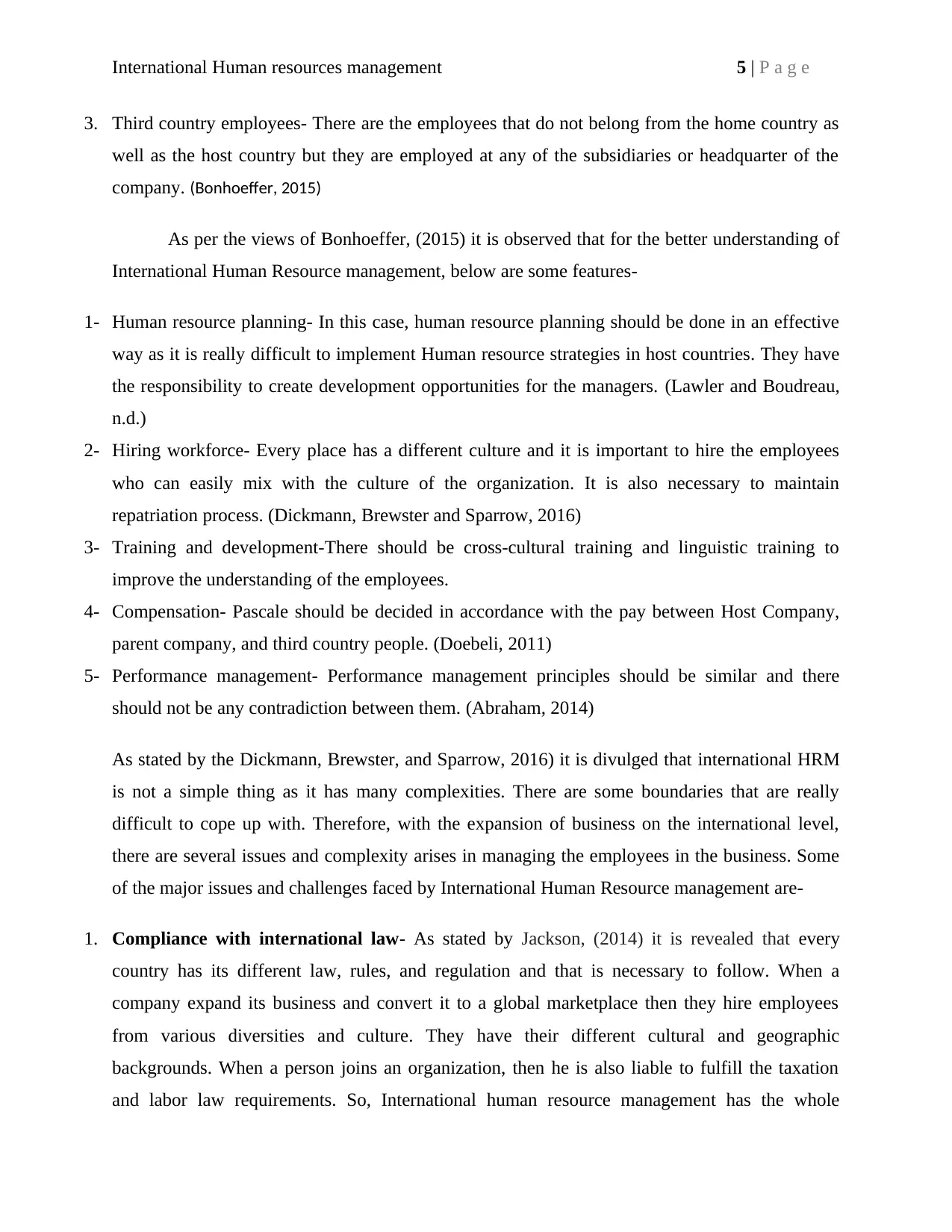
International Human resources management 5 | P a g e
3. Third country employees- There are the employees that do not belong from the home country as
well as the host country but they are employed at any of the subsidiaries or headquarter of the
company. (Bonhoeffer, 2015)
As per the views of Bonhoeffer, (2015) it is observed that for the better understanding of
International Human Resource management, below are some features-
1- Human resource planning- In this case, human resource planning should be done in an effective
way as it is really difficult to implement Human resource strategies in host countries. They have
the responsibility to create development opportunities for the managers. (Lawler and Boudreau,
n.d.)
2- Hiring workforce- Every place has a different culture and it is important to hire the employees
who can easily mix with the culture of the organization. It is also necessary to maintain
repatriation process. (Dickmann, Brewster and Sparrow, 2016)
3- Training and development-There should be cross-cultural training and linguistic training to
improve the understanding of the employees.
4- Compensation- Pascale should be decided in accordance with the pay between Host Company,
parent company, and third country people. (Doebeli, 2011)
5- Performance management- Performance management principles should be similar and there
should not be any contradiction between them. (Abraham, 2014)
As stated by the Dickmann, Brewster, and Sparrow, 2016) it is divulged that international HRM
is not a simple thing as it has many complexities. There are some boundaries that are really
difficult to cope up with. Therefore, with the expansion of business on the international level,
there are several issues and complexity arises in managing the employees in the business. Some
of the major issues and challenges faced by International Human Resource management are-
1. Compliance with international law- As stated by Jackson, (2014) it is revealed that every
country has its different law, rules, and regulation and that is necessary to follow. When a
company expand its business and convert it to a global marketplace then they hire employees
from various diversities and culture. They have their different cultural and geographic
backgrounds. When a person joins an organization, then he is also liable to fulfill the taxation
and labor law requirements. So, International human resource management has the whole
3. Third country employees- There are the employees that do not belong from the home country as
well as the host country but they are employed at any of the subsidiaries or headquarter of the
company. (Bonhoeffer, 2015)
As per the views of Bonhoeffer, (2015) it is observed that for the better understanding of
International Human Resource management, below are some features-
1- Human resource planning- In this case, human resource planning should be done in an effective
way as it is really difficult to implement Human resource strategies in host countries. They have
the responsibility to create development opportunities for the managers. (Lawler and Boudreau,
n.d.)
2- Hiring workforce- Every place has a different culture and it is important to hire the employees
who can easily mix with the culture of the organization. It is also necessary to maintain
repatriation process. (Dickmann, Brewster and Sparrow, 2016)
3- Training and development-There should be cross-cultural training and linguistic training to
improve the understanding of the employees.
4- Compensation- Pascale should be decided in accordance with the pay between Host Company,
parent company, and third country people. (Doebeli, 2011)
5- Performance management- Performance management principles should be similar and there
should not be any contradiction between them. (Abraham, 2014)
As stated by the Dickmann, Brewster, and Sparrow, 2016) it is divulged that international HRM
is not a simple thing as it has many complexities. There are some boundaries that are really
difficult to cope up with. Therefore, with the expansion of business on the international level,
there are several issues and complexity arises in managing the employees in the business. Some
of the major issues and challenges faced by International Human Resource management are-
1. Compliance with international law- As stated by Jackson, (2014) it is revealed that every
country has its different law, rules, and regulation and that is necessary to follow. When a
company expand its business and convert it to a global marketplace then they hire employees
from various diversities and culture. They have their different cultural and geographic
backgrounds. When a person joins an organization, then he is also liable to fulfill the taxation
and labor law requirements. So, International human resource management has the whole
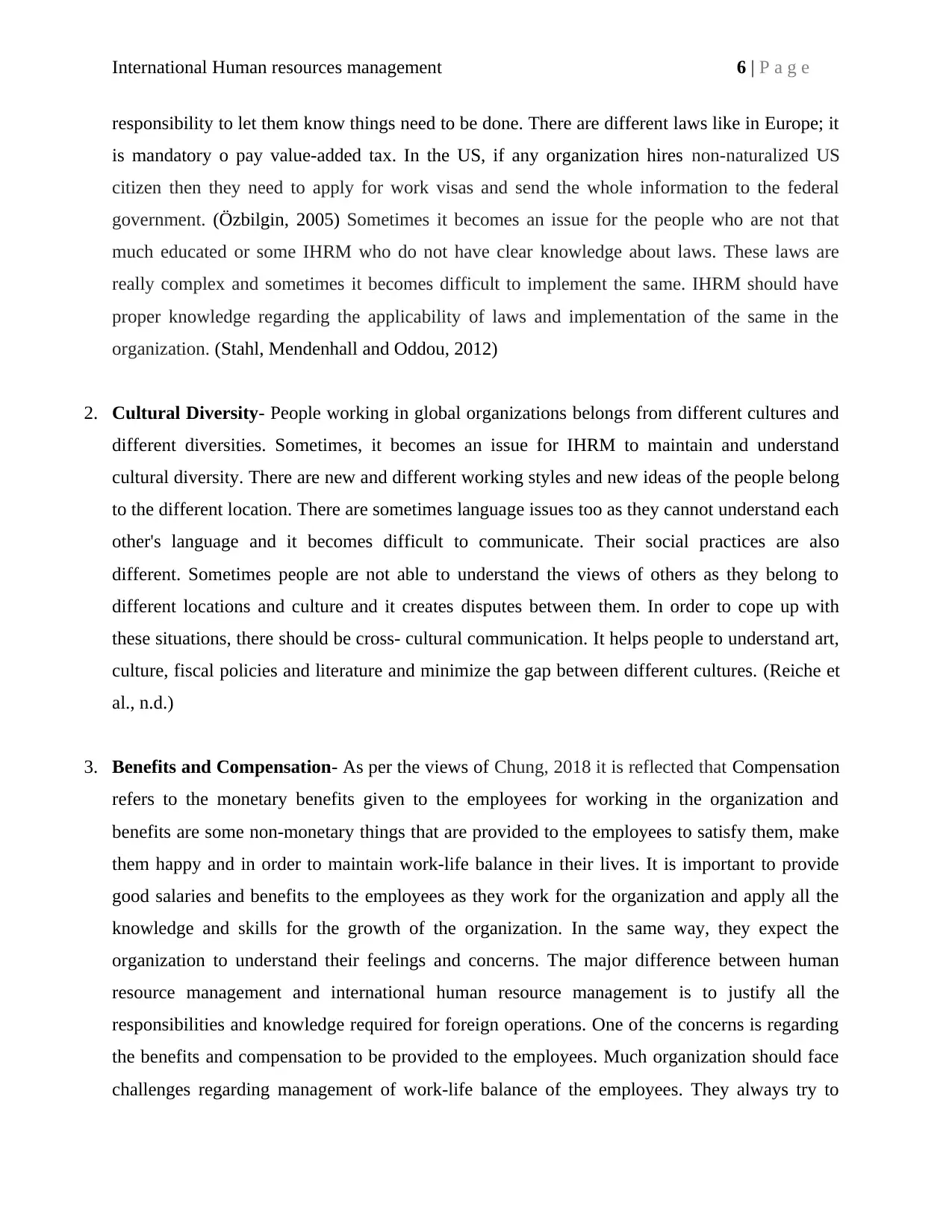
International Human resources management 6 | P a g e
responsibility to let them know things need to be done. There are different laws like in Europe; it
is mandatory o pay value-added tax. In the US, if any organization hires non-naturalized US
citizen then they need to apply for work visas and send the whole information to the federal
government. (Özbilgin, 2005) Sometimes it becomes an issue for the people who are not that
much educated or some IHRM who do not have clear knowledge about laws. These laws are
really complex and sometimes it becomes difficult to implement the same. IHRM should have
proper knowledge regarding the applicability of laws and implementation of the same in the
organization. (Stahl, Mendenhall and Oddou, 2012)
2. Cultural Diversity- People working in global organizations belongs from different cultures and
different diversities. Sometimes, it becomes an issue for IHRM to maintain and understand
cultural diversity. There are new and different working styles and new ideas of the people belong
to the different location. There are sometimes language issues too as they cannot understand each
other's language and it becomes difficult to communicate. Their social practices are also
different. Sometimes people are not able to understand the views of others as they belong to
different locations and culture and it creates disputes between them. In order to cope up with
these situations, there should be cross- cultural communication. It helps people to understand art,
culture, fiscal policies and literature and minimize the gap between different cultures. (Reiche et
al., n.d.)
3. Benefits and Compensation- As per the views of Chung, 2018 it is reflected that Compensation
refers to the monetary benefits given to the employees for working in the organization and
benefits are some non-monetary things that are provided to the employees to satisfy them, make
them happy and in order to maintain work-life balance in their lives. It is important to provide
good salaries and benefits to the employees as they work for the organization and apply all the
knowledge and skills for the growth of the organization. In the same way, they expect the
organization to understand their feelings and concerns. The major difference between human
resource management and international human resource management is to justify all the
responsibilities and knowledge required for foreign operations. One of the concerns is regarding
the benefits and compensation to be provided to the employees. Much organization should face
challenges regarding management of work-life balance of the employees. They always try to
responsibility to let them know things need to be done. There are different laws like in Europe; it
is mandatory o pay value-added tax. In the US, if any organization hires non-naturalized US
citizen then they need to apply for work visas and send the whole information to the federal
government. (Özbilgin, 2005) Sometimes it becomes an issue for the people who are not that
much educated or some IHRM who do not have clear knowledge about laws. These laws are
really complex and sometimes it becomes difficult to implement the same. IHRM should have
proper knowledge regarding the applicability of laws and implementation of the same in the
organization. (Stahl, Mendenhall and Oddou, 2012)
2. Cultural Diversity- People working in global organizations belongs from different cultures and
different diversities. Sometimes, it becomes an issue for IHRM to maintain and understand
cultural diversity. There are new and different working styles and new ideas of the people belong
to the different location. There are sometimes language issues too as they cannot understand each
other's language and it becomes difficult to communicate. Their social practices are also
different. Sometimes people are not able to understand the views of others as they belong to
different locations and culture and it creates disputes between them. In order to cope up with
these situations, there should be cross- cultural communication. It helps people to understand art,
culture, fiscal policies and literature and minimize the gap between different cultures. (Reiche et
al., n.d.)
3. Benefits and Compensation- As per the views of Chung, 2018 it is reflected that Compensation
refers to the monetary benefits given to the employees for working in the organization and
benefits are some non-monetary things that are provided to the employees to satisfy them, make
them happy and in order to maintain work-life balance in their lives. It is important to provide
good salaries and benefits to the employees as they work for the organization and apply all the
knowledge and skills for the growth of the organization. In the same way, they expect the
organization to understand their feelings and concerns. The major difference between human
resource management and international human resource management is to justify all the
responsibilities and knowledge required for foreign operations. One of the concerns is regarding
the benefits and compensation to be provided to the employees. Much organization should face
challenges regarding management of work-life balance of the employees. They always try to
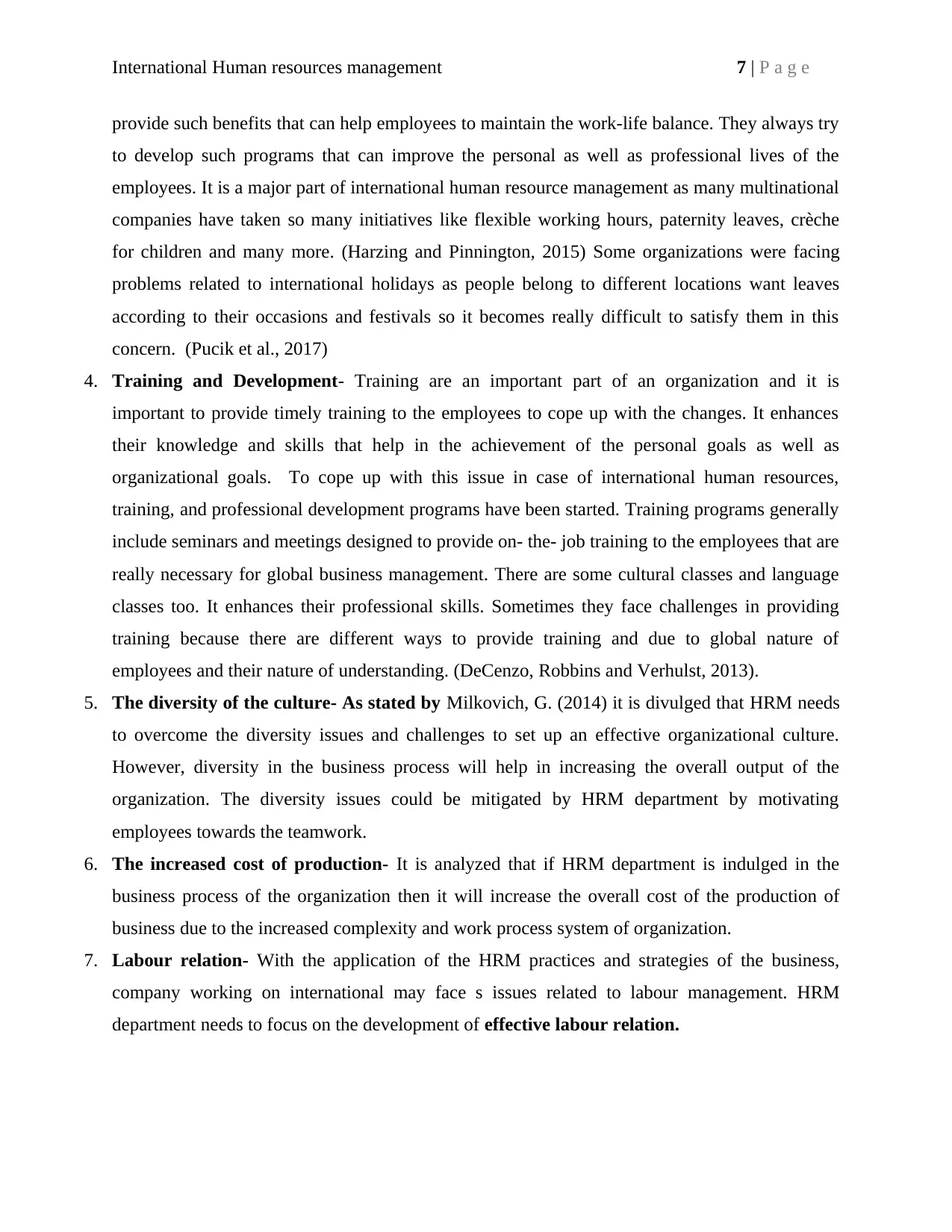
International Human resources management 7 | P a g e
provide such benefits that can help employees to maintain the work-life balance. They always try
to develop such programs that can improve the personal as well as professional lives of the
employees. It is a major part of international human resource management as many multinational
companies have taken so many initiatives like flexible working hours, paternity leaves, crèche
for children and many more. (Harzing and Pinnington, 2015) Some organizations were facing
problems related to international holidays as people belong to different locations want leaves
according to their occasions and festivals so it becomes really difficult to satisfy them in this
concern. (Pucik et al., 2017)
4. Training and Development- Training are an important part of an organization and it is
important to provide timely training to the employees to cope up with the changes. It enhances
their knowledge and skills that help in the achievement of the personal goals as well as
organizational goals. To cope up with this issue in case of international human resources,
training, and professional development programs have been started. Training programs generally
include seminars and meetings designed to provide on- the- job training to the employees that are
really necessary for global business management. There are some cultural classes and language
classes too. It enhances their professional skills. Sometimes they face challenges in providing
training because there are different ways to provide training and due to global nature of
employees and their nature of understanding. (DeCenzo, Robbins and Verhulst, 2013).
5. The diversity of the culture- As stated by Milkovich, G. (2014) it is divulged that HRM needs
to overcome the diversity issues and challenges to set up an effective organizational culture.
However, diversity in the business process will help in increasing the overall output of the
organization. The diversity issues could be mitigated by HRM department by motivating
employees towards the teamwork.
6. The increased cost of production- It is analyzed that if HRM department is indulged in the
business process of the organization then it will increase the overall cost of the production of
business due to the increased complexity and work process system of organization.
7. Labour relation- With the application of the HRM practices and strategies of the business,
company working on international may face s issues related to labour management. HRM
department needs to focus on the development of effective labour relation.
provide such benefits that can help employees to maintain the work-life balance. They always try
to develop such programs that can improve the personal as well as professional lives of the
employees. It is a major part of international human resource management as many multinational
companies have taken so many initiatives like flexible working hours, paternity leaves, crèche
for children and many more. (Harzing and Pinnington, 2015) Some organizations were facing
problems related to international holidays as people belong to different locations want leaves
according to their occasions and festivals so it becomes really difficult to satisfy them in this
concern. (Pucik et al., 2017)
4. Training and Development- Training are an important part of an organization and it is
important to provide timely training to the employees to cope up with the changes. It enhances
their knowledge and skills that help in the achievement of the personal goals as well as
organizational goals. To cope up with this issue in case of international human resources,
training, and professional development programs have been started. Training programs generally
include seminars and meetings designed to provide on- the- job training to the employees that are
really necessary for global business management. There are some cultural classes and language
classes too. It enhances their professional skills. Sometimes they face challenges in providing
training because there are different ways to provide training and due to global nature of
employees and their nature of understanding. (DeCenzo, Robbins and Verhulst, 2013).
5. The diversity of the culture- As stated by Milkovich, G. (2014) it is divulged that HRM needs
to overcome the diversity issues and challenges to set up an effective organizational culture.
However, diversity in the business process will help in increasing the overall output of the
organization. The diversity issues could be mitigated by HRM department by motivating
employees towards the teamwork.
6. The increased cost of production- It is analyzed that if HRM department is indulged in the
business process of the organization then it will increase the overall cost of the production of
business due to the increased complexity and work process system of organization.
7. Labour relation- With the application of the HRM practices and strategies of the business,
company working on international may face s issues related to labour management. HRM
department needs to focus on the development of effective labour relation.
Paraphrase This Document
Need a fresh take? Get an instant paraphrase of this document with our AI Paraphraser
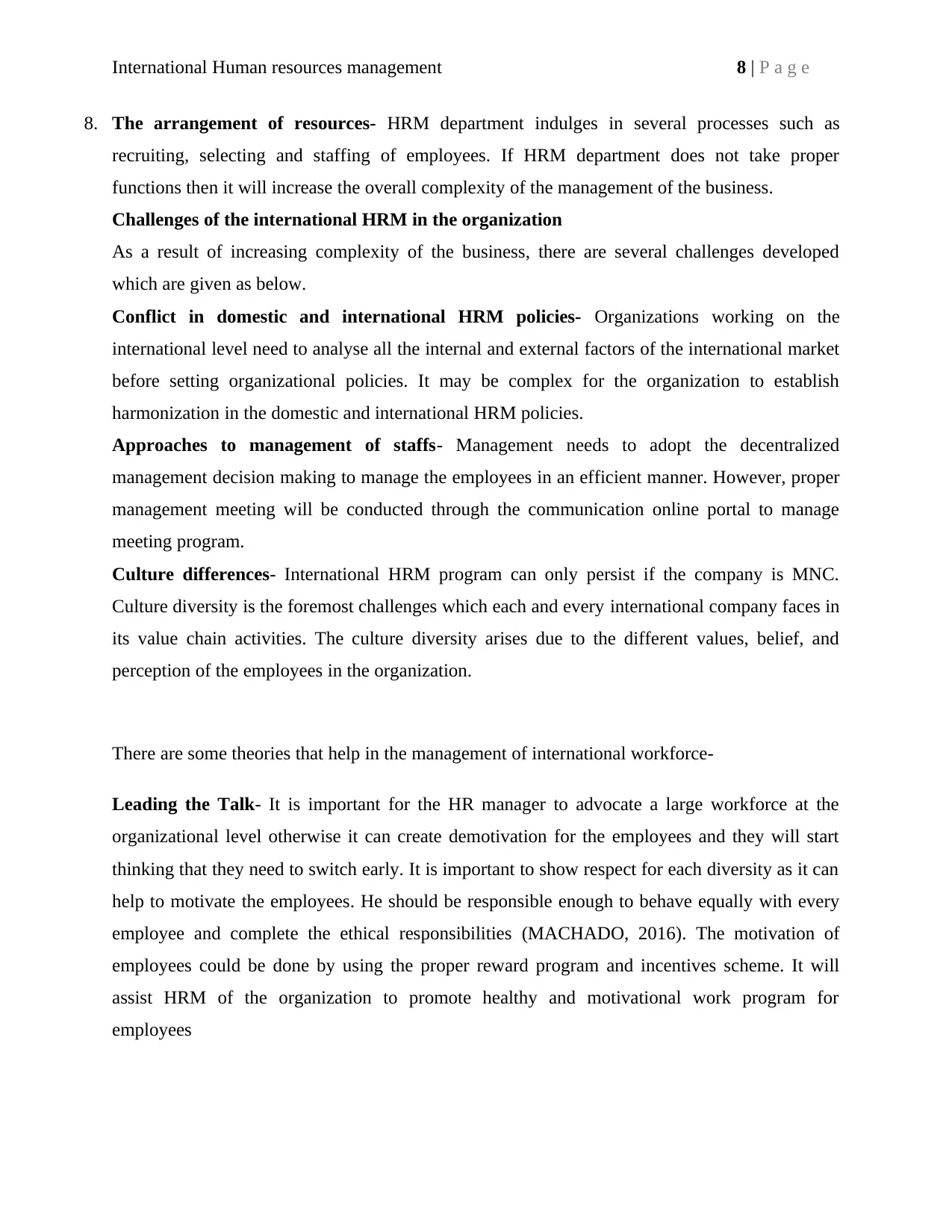
International Human resources management 8 | P a g e
8. The arrangement of resources- HRM department indulges in several processes such as
recruiting, selecting and staffing of employees. If HRM department does not take proper
functions then it will increase the overall complexity of the management of the business.
Challenges of the international HRM in the organization
As a result of increasing complexity of the business, there are several challenges developed
which are given as below.
Conflict in domestic and international HRM policies- Organizations working on the
international level need to analyse all the internal and external factors of the international market
before setting organizational policies. It may be complex for the organization to establish
harmonization in the domestic and international HRM policies.
Approaches to management of staffs- Management needs to adopt the decentralized
management decision making to manage the employees in an efficient manner. However, proper
management meeting will be conducted through the communication online portal to manage
meeting program.
Culture differences- International HRM program can only persist if the company is MNC.
Culture diversity is the foremost challenges which each and every international company faces in
its value chain activities. The culture diversity arises due to the different values, belief, and
perception of the employees in the organization.
There are some theories that help in the management of international workforce-
Leading the Talk- It is important for the HR manager to advocate a large workforce at the
organizational level otherwise it can create demotivation for the employees and they will start
thinking that they need to switch early. It is important to show respect for each diversity as it can
help to motivate the employees. He should be responsible enough to behave equally with every
employee and complete the ethical responsibilities (MACHADO, 2016). The motivation of
employees could be done by using the proper reward program and incentives scheme. It will
assist HRM of the organization to promote healthy and motivational work program for
employees
8. The arrangement of resources- HRM department indulges in several processes such as
recruiting, selecting and staffing of employees. If HRM department does not take proper
functions then it will increase the overall complexity of the management of the business.
Challenges of the international HRM in the organization
As a result of increasing complexity of the business, there are several challenges developed
which are given as below.
Conflict in domestic and international HRM policies- Organizations working on the
international level need to analyse all the internal and external factors of the international market
before setting organizational policies. It may be complex for the organization to establish
harmonization in the domestic and international HRM policies.
Approaches to management of staffs- Management needs to adopt the decentralized
management decision making to manage the employees in an efficient manner. However, proper
management meeting will be conducted through the communication online portal to manage
meeting program.
Culture differences- International HRM program can only persist if the company is MNC.
Culture diversity is the foremost challenges which each and every international company faces in
its value chain activities. The culture diversity arises due to the different values, belief, and
perception of the employees in the organization.
There are some theories that help in the management of international workforce-
Leading the Talk- It is important for the HR manager to advocate a large workforce at the
organizational level otherwise it can create demotivation for the employees and they will start
thinking that they need to switch early. It is important to show respect for each diversity as it can
help to motivate the employees. He should be responsible enough to behave equally with every
employee and complete the ethical responsibilities (MACHADO, 2016). The motivation of
employees could be done by using the proper reward program and incentives scheme. It will
assist HRM of the organization to promote healthy and motivational work program for
employees
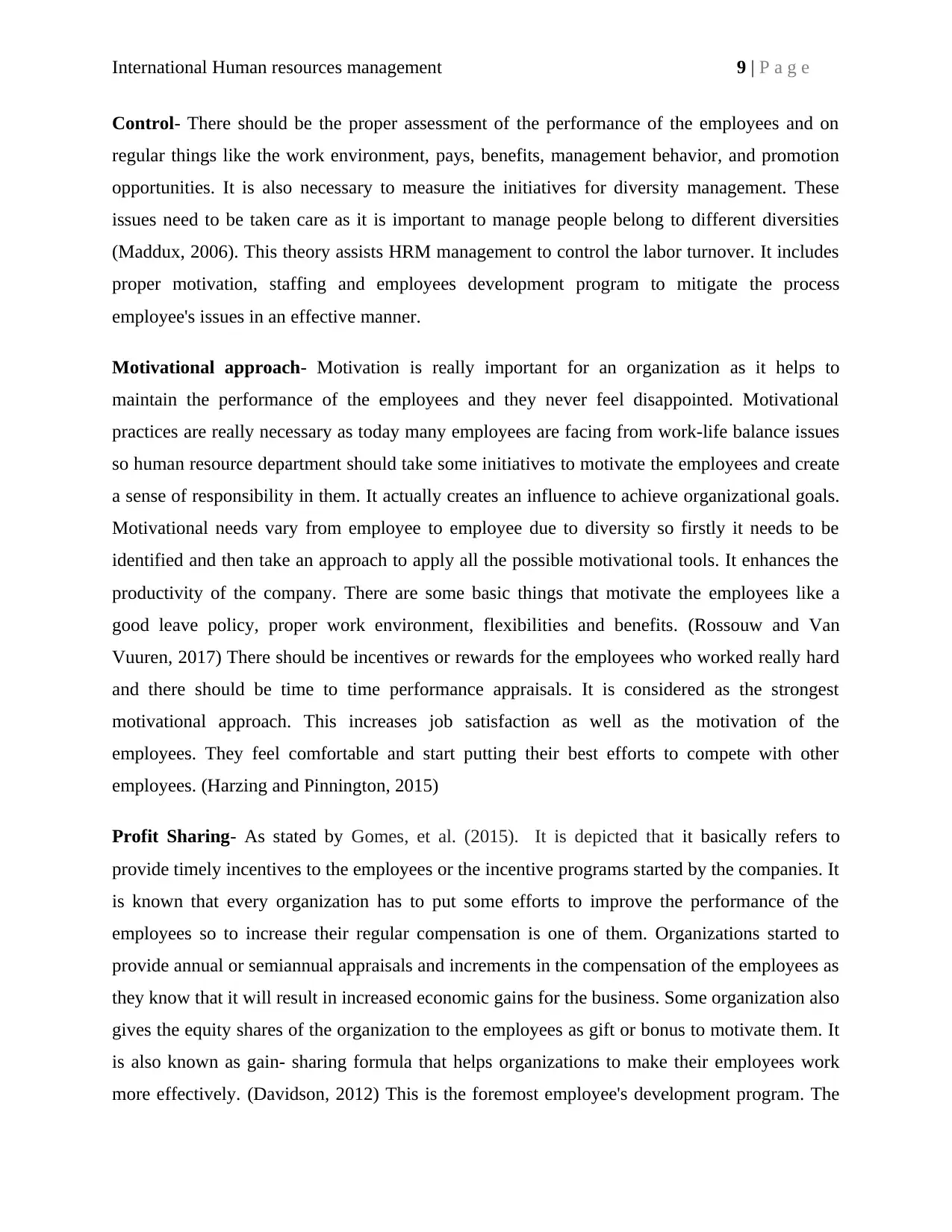
International Human resources management 9 | P a g e
Control- There should be the proper assessment of the performance of the employees and on
regular things like the work environment, pays, benefits, management behavior, and promotion
opportunities. It is also necessary to measure the initiatives for diversity management. These
issues need to be taken care as it is important to manage people belong to different diversities
(Maddux, 2006). This theory assists HRM management to control the labor turnover. It includes
proper motivation, staffing and employees development program to mitigate the process
employee's issues in an effective manner.
Motivational approach- Motivation is really important for an organization as it helps to
maintain the performance of the employees and they never feel disappointed. Motivational
practices are really necessary as today many employees are facing from work-life balance issues
so human resource department should take some initiatives to motivate the employees and create
a sense of responsibility in them. It actually creates an influence to achieve organizational goals.
Motivational needs vary from employee to employee due to diversity so firstly it needs to be
identified and then take an approach to apply all the possible motivational tools. It enhances the
productivity of the company. There are some basic things that motivate the employees like a
good leave policy, proper work environment, flexibilities and benefits. (Rossouw and Van
Vuuren, 2017) There should be incentives or rewards for the employees who worked really hard
and there should be time to time performance appraisals. It is considered as the strongest
motivational approach. This increases job satisfaction as well as the motivation of the
employees. They feel comfortable and start putting their best efforts to compete with other
employees. (Harzing and Pinnington, 2015)
Profit Sharing- As stated by Gomes, et al. (2015). It is depicted that it basically refers to
provide timely incentives to the employees or the incentive programs started by the companies. It
is known that every organization has to put some efforts to improve the performance of the
employees so to increase their regular compensation is one of them. Organizations started to
provide annual or semiannual appraisals and increments in the compensation of the employees as
they know that it will result in increased economic gains for the business. Some organization also
gives the equity shares of the organization to the employees as gift or bonus to motivate them. It
is also known as gain- sharing formula that helps organizations to make their employees work
more effectively. (Davidson, 2012) This is the foremost employee's development program. The
Control- There should be the proper assessment of the performance of the employees and on
regular things like the work environment, pays, benefits, management behavior, and promotion
opportunities. It is also necessary to measure the initiatives for diversity management. These
issues need to be taken care as it is important to manage people belong to different diversities
(Maddux, 2006). This theory assists HRM management to control the labor turnover. It includes
proper motivation, staffing and employees development program to mitigate the process
employee's issues in an effective manner.
Motivational approach- Motivation is really important for an organization as it helps to
maintain the performance of the employees and they never feel disappointed. Motivational
practices are really necessary as today many employees are facing from work-life balance issues
so human resource department should take some initiatives to motivate the employees and create
a sense of responsibility in them. It actually creates an influence to achieve organizational goals.
Motivational needs vary from employee to employee due to diversity so firstly it needs to be
identified and then take an approach to apply all the possible motivational tools. It enhances the
productivity of the company. There are some basic things that motivate the employees like a
good leave policy, proper work environment, flexibilities and benefits. (Rossouw and Van
Vuuren, 2017) There should be incentives or rewards for the employees who worked really hard
and there should be time to time performance appraisals. It is considered as the strongest
motivational approach. This increases job satisfaction as well as the motivation of the
employees. They feel comfortable and start putting their best efforts to compete with other
employees. (Harzing and Pinnington, 2015)
Profit Sharing- As stated by Gomes, et al. (2015). It is depicted that it basically refers to
provide timely incentives to the employees or the incentive programs started by the companies. It
is known that every organization has to put some efforts to improve the performance of the
employees so to increase their regular compensation is one of them. Organizations started to
provide annual or semiannual appraisals and increments in the compensation of the employees as
they know that it will result in increased economic gains for the business. Some organization also
gives the equity shares of the organization to the employees as gift or bonus to motivate them. It
is also known as gain- sharing formula that helps organizations to make their employees work
more effectively. (Davidson, 2012) This is the foremost employee's development program. The
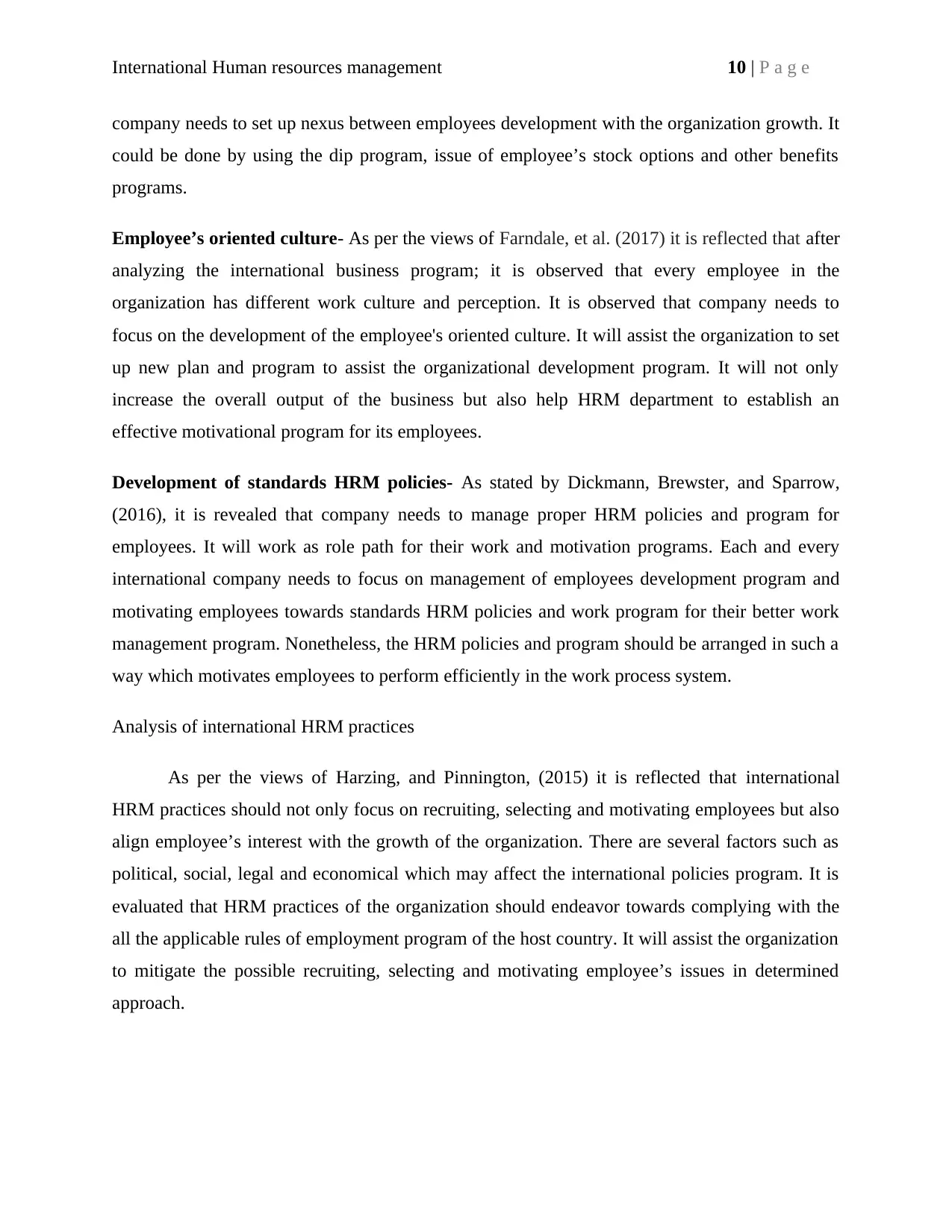
International Human resources management 10 | P a g e
company needs to set up nexus between employees development with the organization growth. It
could be done by using the dip program, issue of employee’s stock options and other benefits
programs.
Employee’s oriented culture- As per the views of Farndale, et al. (2017) it is reflected that after
analyzing the international business program; it is observed that every employee in the
organization has different work culture and perception. It is observed that company needs to
focus on the development of the employee's oriented culture. It will assist the organization to set
up new plan and program to assist the organizational development program. It will not only
increase the overall output of the business but also help HRM department to establish an
effective motivational program for its employees.
Development of standards HRM policies- As stated by Dickmann, Brewster, and Sparrow,
(2016), it is revealed that company needs to manage proper HRM policies and program for
employees. It will work as role path for their work and motivation programs. Each and every
international company needs to focus on management of employees development program and
motivating employees towards standards HRM policies and work program for their better work
management program. Nonetheless, the HRM policies and program should be arranged in such a
way which motivates employees to perform efficiently in the work process system.
Analysis of international HRM practices
As per the views of Harzing, and Pinnington, (2015) it is reflected that international
HRM practices should not only focus on recruiting, selecting and motivating employees but also
align employee’s interest with the growth of the organization. There are several factors such as
political, social, legal and economical which may affect the international policies program. It is
evaluated that HRM practices of the organization should endeavor towards complying with the
all the applicable rules of employment program of the host country. It will assist the organization
to mitigate the possible recruiting, selecting and motivating employee’s issues in determined
approach.
company needs to set up nexus between employees development with the organization growth. It
could be done by using the dip program, issue of employee’s stock options and other benefits
programs.
Employee’s oriented culture- As per the views of Farndale, et al. (2017) it is reflected that after
analyzing the international business program; it is observed that every employee in the
organization has different work culture and perception. It is observed that company needs to
focus on the development of the employee's oriented culture. It will assist the organization to set
up new plan and program to assist the organizational development program. It will not only
increase the overall output of the business but also help HRM department to establish an
effective motivational program for its employees.
Development of standards HRM policies- As stated by Dickmann, Brewster, and Sparrow,
(2016), it is revealed that company needs to manage proper HRM policies and program for
employees. It will work as role path for their work and motivation programs. Each and every
international company needs to focus on management of employees development program and
motivating employees towards standards HRM policies and work program for their better work
management program. Nonetheless, the HRM policies and program should be arranged in such a
way which motivates employees to perform efficiently in the work process system.
Analysis of international HRM practices
As per the views of Harzing, and Pinnington, (2015) it is reflected that international
HRM practices should not only focus on recruiting, selecting and motivating employees but also
align employee’s interest with the growth of the organization. There are several factors such as
political, social, legal and economical which may affect the international policies program. It is
evaluated that HRM practices of the organization should endeavor towards complying with the
all the applicable rules of employment program of the host country. It will assist the organization
to mitigate the possible recruiting, selecting and motivating employee’s issues in determined
approach.
Secure Best Marks with AI Grader
Need help grading? Try our AI Grader for instant feedback on your assignments.
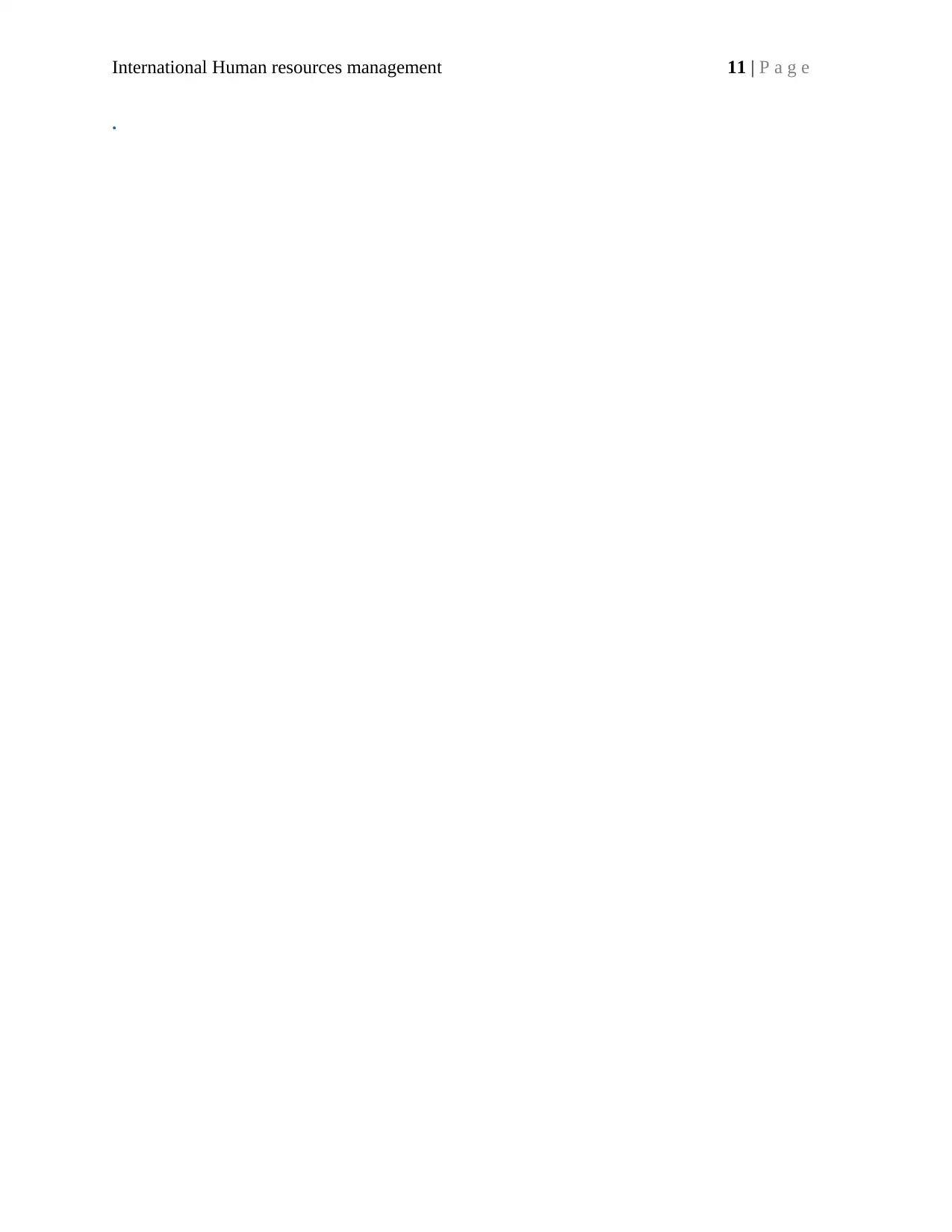
International Human resources management 11 | P a g e
.
.
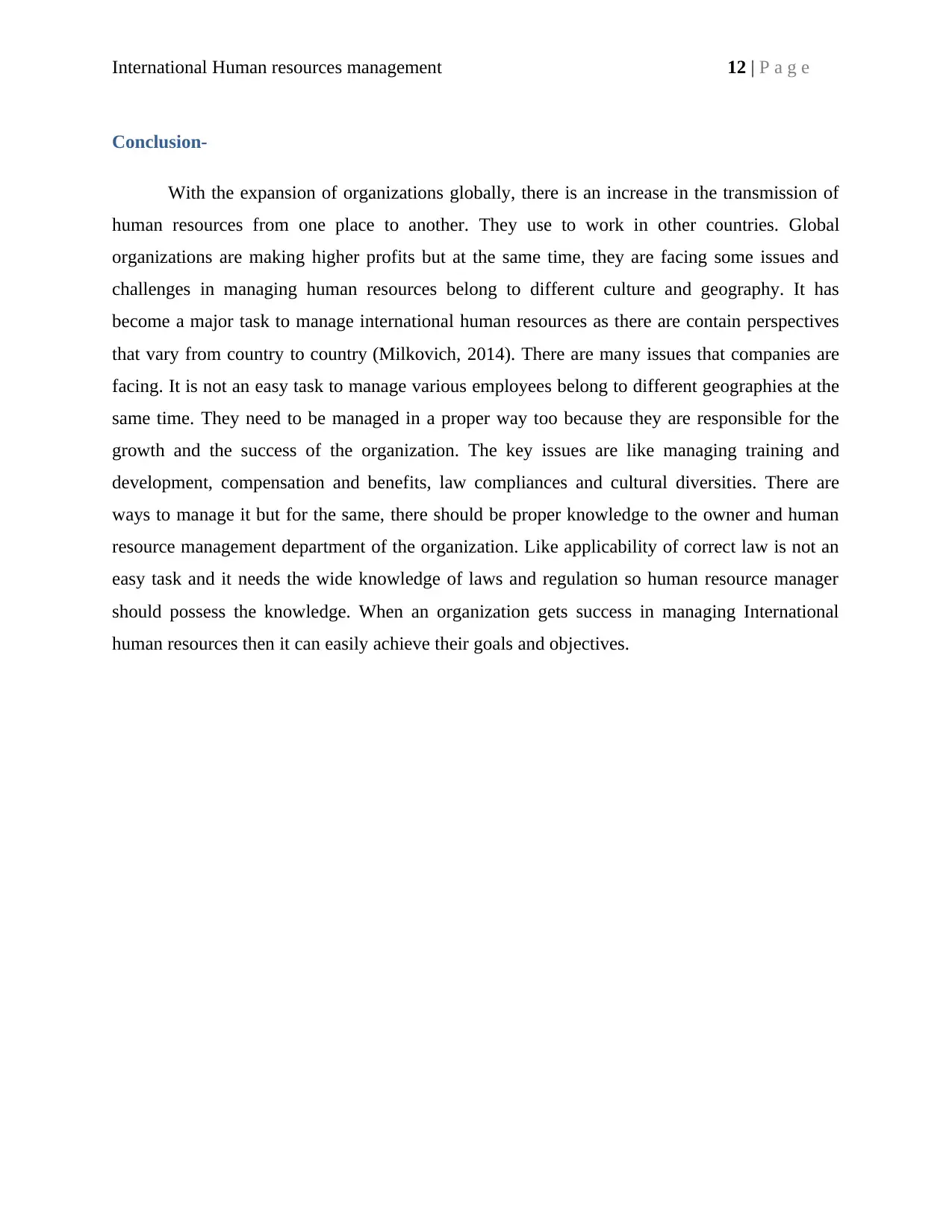
International Human resources management 12 | P a g e
Conclusion-
With the expansion of organizations globally, there is an increase in the transmission of
human resources from one place to another. They use to work in other countries. Global
organizations are making higher profits but at the same time, they are facing some issues and
challenges in managing human resources belong to different culture and geography. It has
become a major task to manage international human resources as there are contain perspectives
that vary from country to country (Milkovich, 2014). There are many issues that companies are
facing. It is not an easy task to manage various employees belong to different geographies at the
same time. They need to be managed in a proper way too because they are responsible for the
growth and the success of the organization. The key issues are like managing training and
development, compensation and benefits, law compliances and cultural diversities. There are
ways to manage it but for the same, there should be proper knowledge to the owner and human
resource management department of the organization. Like applicability of correct law is not an
easy task and it needs the wide knowledge of laws and regulation so human resource manager
should possess the knowledge. When an organization gets success in managing International
human resources then it can easily achieve their goals and objectives.
Conclusion-
With the expansion of organizations globally, there is an increase in the transmission of
human resources from one place to another. They use to work in other countries. Global
organizations are making higher profits but at the same time, they are facing some issues and
challenges in managing human resources belong to different culture and geography. It has
become a major task to manage international human resources as there are contain perspectives
that vary from country to country (Milkovich, 2014). There are many issues that companies are
facing. It is not an easy task to manage various employees belong to different geographies at the
same time. They need to be managed in a proper way too because they are responsible for the
growth and the success of the organization. The key issues are like managing training and
development, compensation and benefits, law compliances and cultural diversities. There are
ways to manage it but for the same, there should be proper knowledge to the owner and human
resource management department of the organization. Like applicability of correct law is not an
easy task and it needs the wide knowledge of laws and regulation so human resource manager
should possess the knowledge. When an organization gets success in managing International
human resources then it can easily achieve their goals and objectives.
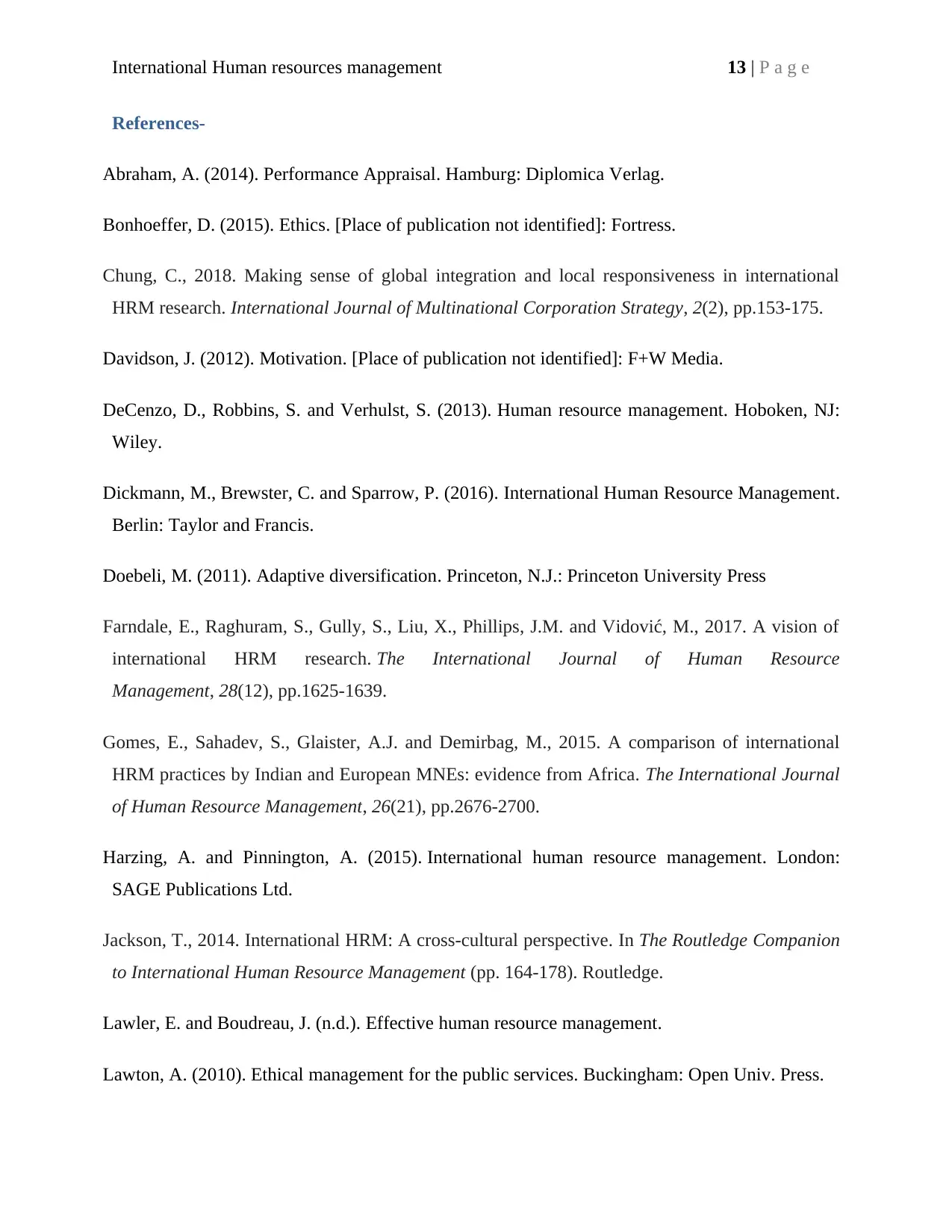
International Human resources management 13 | P a g e
References-
Abraham, A. (2014). Performance Appraisal. Hamburg: Diplomica Verlag.
Bonhoeffer, D. (2015). Ethics. [Place of publication not identified]: Fortress.
Chung, C., 2018. Making sense of global integration and local responsiveness in international
HRM research. International Journal of Multinational Corporation Strategy, 2(2), pp.153-175.
Davidson, J. (2012). Motivation. [Place of publication not identified]: F+W Media.
DeCenzo, D., Robbins, S. and Verhulst, S. (2013). Human resource management. Hoboken, NJ:
Wiley.
Dickmann, M., Brewster, C. and Sparrow, P. (2016). International Human Resource Management.
Berlin: Taylor and Francis.
Doebeli, M. (2011). Adaptive diversification. Princeton, N.J.: Princeton University Press
Farndale, E., Raghuram, S., Gully, S., Liu, X., Phillips, J.M. and Vidović, M., 2017. A vision of
international HRM research. The International Journal of Human Resource
Management, 28(12), pp.1625-1639.
Gomes, E., Sahadev, S., Glaister, A.J. and Demirbag, M., 2015. A comparison of international
HRM practices by Indian and European MNEs: evidence from Africa. The International Journal
of Human Resource Management, 26(21), pp.2676-2700.
Harzing, A. and Pinnington, A. (2015). International human resource management. London:
SAGE Publications Ltd.
Jackson, T., 2014. International HRM: A cross-cultural perspective. In The Routledge Companion
to International Human Resource Management (pp. 164-178). Routledge.
Lawler, E. and Boudreau, J. (n.d.). Effective human resource management.
Lawton, A. (2010). Ethical management for the public services. Buckingham: Open Univ. Press.
References-
Abraham, A. (2014). Performance Appraisal. Hamburg: Diplomica Verlag.
Bonhoeffer, D. (2015). Ethics. [Place of publication not identified]: Fortress.
Chung, C., 2018. Making sense of global integration and local responsiveness in international
HRM research. International Journal of Multinational Corporation Strategy, 2(2), pp.153-175.
Davidson, J. (2012). Motivation. [Place of publication not identified]: F+W Media.
DeCenzo, D., Robbins, S. and Verhulst, S. (2013). Human resource management. Hoboken, NJ:
Wiley.
Dickmann, M., Brewster, C. and Sparrow, P. (2016). International Human Resource Management.
Berlin: Taylor and Francis.
Doebeli, M. (2011). Adaptive diversification. Princeton, N.J.: Princeton University Press
Farndale, E., Raghuram, S., Gully, S., Liu, X., Phillips, J.M. and Vidović, M., 2017. A vision of
international HRM research. The International Journal of Human Resource
Management, 28(12), pp.1625-1639.
Gomes, E., Sahadev, S., Glaister, A.J. and Demirbag, M., 2015. A comparison of international
HRM practices by Indian and European MNEs: evidence from Africa. The International Journal
of Human Resource Management, 26(21), pp.2676-2700.
Harzing, A. and Pinnington, A. (2015). International human resource management. London:
SAGE Publications Ltd.
Jackson, T., 2014. International HRM: A cross-cultural perspective. In The Routledge Companion
to International Human Resource Management (pp. 164-178). Routledge.
Lawler, E. and Boudreau, J. (n.d.). Effective human resource management.
Lawton, A. (2010). Ethical management for the public services. Buckingham: Open Univ. Press.
Paraphrase This Document
Need a fresh take? Get an instant paraphrase of this document with our AI Paraphraser
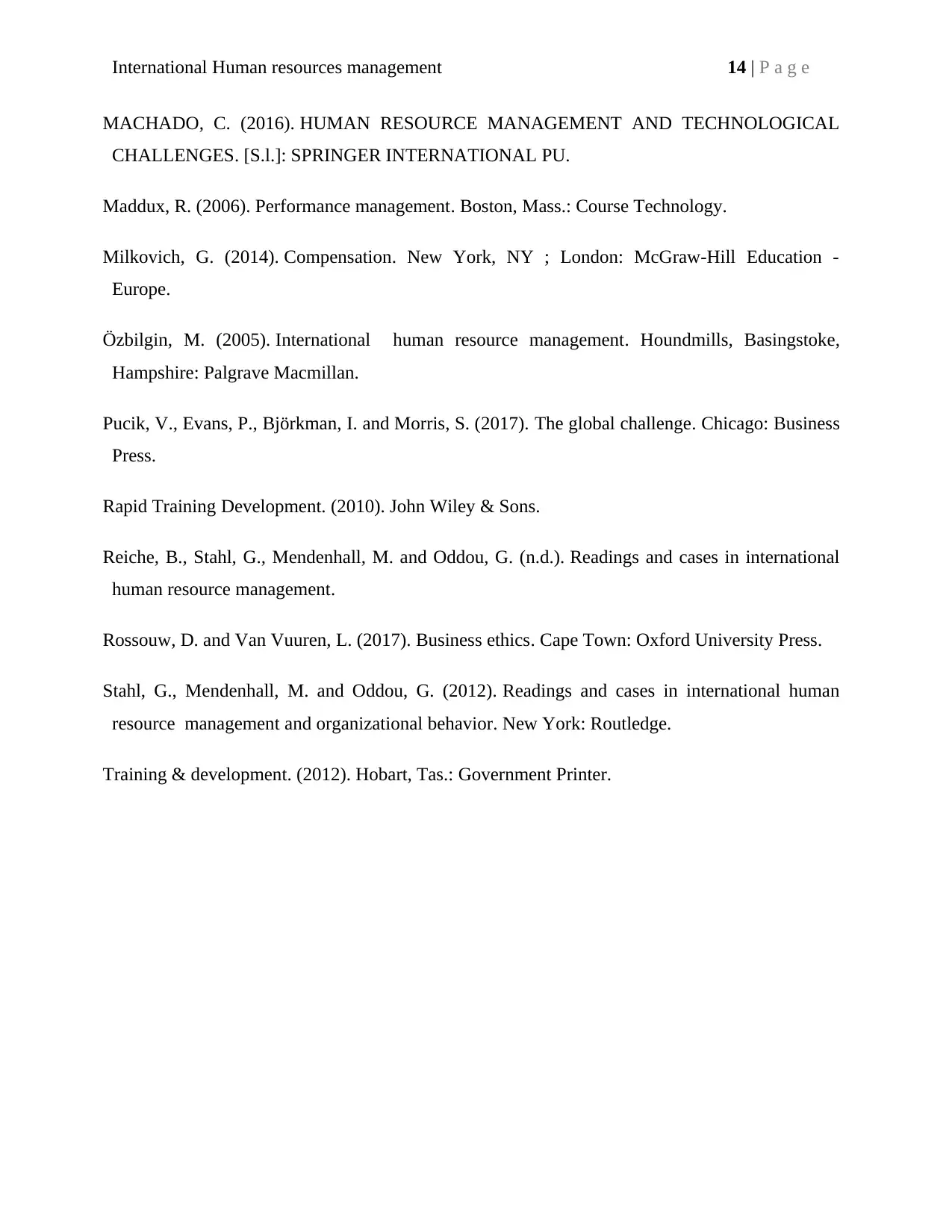
International Human resources management 14 | P a g e
MACHADO, C. (2016). HUMAN RESOURCE MANAGEMENT AND TECHNOLOGICAL
CHALLENGES. [S.l.]: SPRINGER INTERNATIONAL PU.
Maddux, R. (2006). Performance management. Boston, Mass.: Course Technology.
Milkovich, G. (2014). Compensation. New York, NY ; London: McGraw-Hill Education -
Europe.Ö
zbilgin, M. (2005). International human resource management. Houndmills, Basingstoke,
Hampshire: Palgrave Macmillan.
Pucik, V., Evans, P., Björkman, I. and Morris, S. (2017). The global challenge. Chicago: Business
Press.
Rapid Training Development. (2010). John Wiley & Sons.
Reiche, B., Stahl, G., Mendenhall, M. and Oddou, G. (n.d.). Readings and cases in international
human resource management.
Rossouw, D. and Van Vuuren, L. (2017). Business ethics. Cape Town: Oxford University Press.
Stahl, G., Mendenhall, M. and Oddou, G. (2012). Readings and cases in international human
resource management and organizational behavior. New York: Routledge.
Training & development. (2012). Hobart, Tas.: Government Printer.
MACHADO, C. (2016). HUMAN RESOURCE MANAGEMENT AND TECHNOLOGICAL
CHALLENGES. [S.l.]: SPRINGER INTERNATIONAL PU.
Maddux, R. (2006). Performance management. Boston, Mass.: Course Technology.
Milkovich, G. (2014). Compensation. New York, NY ; London: McGraw-Hill Education -
Europe.Ö
zbilgin, M. (2005). International human resource management. Houndmills, Basingstoke,
Hampshire: Palgrave Macmillan.
Pucik, V., Evans, P., Björkman, I. and Morris, S. (2017). The global challenge. Chicago: Business
Press.
Rapid Training Development. (2010). John Wiley & Sons.
Reiche, B., Stahl, G., Mendenhall, M. and Oddou, G. (n.d.). Readings and cases in international
human resource management.
Rossouw, D. and Van Vuuren, L. (2017). Business ethics. Cape Town: Oxford University Press.
Stahl, G., Mendenhall, M. and Oddou, G. (2012). Readings and cases in international human
resource management and organizational behavior. New York: Routledge.
Training & development. (2012). Hobart, Tas.: Government Printer.
1 out of 14
Related Documents
Your All-in-One AI-Powered Toolkit for Academic Success.
+13062052269
info@desklib.com
Available 24*7 on WhatsApp / Email
![[object Object]](/_next/static/media/star-bottom.7253800d.svg)
Unlock your academic potential
© 2024 | Zucol Services PVT LTD | All rights reserved.





